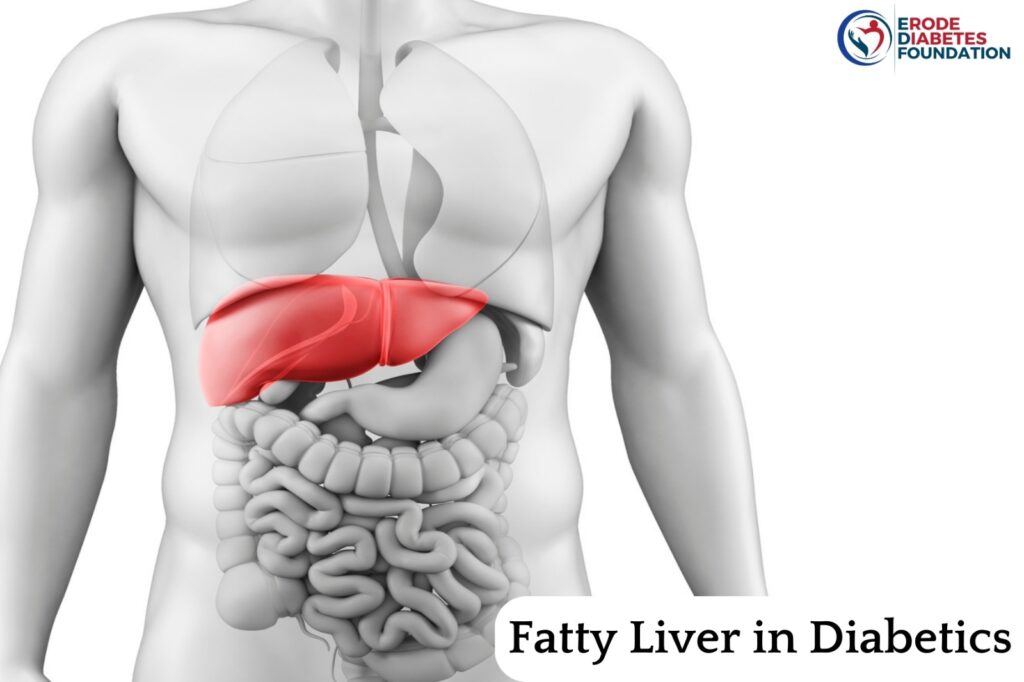Fatty liver disease is a significant health concern, especially for individuals with diabetes. Managing liver health is crucial for diabetics to avoid additional complications such as liver inflammation, cirrhosis, and cardiovascular diseases. In this blog, let’s learn what Fatty Liver in Diabetics , its symptoms, risks, and preventive measures.
What is Fatty Liver Disease?
Fatty liver disease, or non-alcoholic fatty liver disease (NAFLD), occurs when there is an excessive accumulation of fat in the liver cells. This condition is common among diabetics due to the metabolic disturbances associated with diabetes. NAFLD can progress to non-alcoholic steatohepatitis (NASH), which involves inflammation and liver cell damage, potentially leading to fibrosis, cirrhosis, and liver cancer.

Concern for Diabetics
Diabetes and fatty liver often occur together, significantly increasing the risk of liver and cardiovascular diseases. Insulin resistance, a common feature of type 2 diabetes, plays an important role in the development of NAFLD. High blood sugar levels can lead to fat accumulation in the liver, and elevated insulin levels promote further fat storage. Additionally, obesity, dyslipidaemia, and hypertension, often associated with diabetes, contribute to the risk of developing fatty liver disease.
Fatty Liver Symptoms
Fatty liver is often asymptomatic in its early stages, making it difficult to detect without medical tests. As the disease advances, the following symptoms may emerge:
- Persistent tiredness or lack of energy (Fatigue)
- Pain or discomfort in the upper right abdomen
- Unintentional weight loss without alterations in diet or exercise
- General feeling of weakness or sickness
- Yellowing of the skin and eyes, which is a sign of advanced liver disease
- Swelling in the legs and abdomen (oedema and ascites)
Risks Associated with Fatty Liver Disease
If left untreated, fatty liver disease can lead to several serious health issues, including:
- Inflammation and damage to liver cells
- Fibrosis and Cirrhosis: Scarring of liver tissue, which can lead to liver failure
- Increased risk of developing liver cancer
- Higher risk of heart attacks and strokes
- Impaired kidney function due to increased liver fat
- A cluster of conditions including high blood sugar, obesity, and abnormal cholesterol levels
Preventive Measures to Lower the Risk of Fatty Liver Disease
- Follow a nutritious diet that includes plenty of fruits, vegetables, whole grains, lean proteins, and healthy fats. Limit intake of sugar, refined carbohydrates, and saturated fats.
- Reach and sustain a healthy weight by combining proper diet and regular exercise. Even modest weight loss can significantly reduce liver fat.
- Engage in at least 150 minutes of moderate-intensity exercise per week, including aerobic and resistance training.
- Maintain blood glucose levels within target ranges through medication, insulin therapy, and lifestyle changes.
- Regularly check cholesterol and triglyceride levels and manage dyslipidaemia with medications and lifestyle changes.
- Limit or avoid alcohol intake, as it can worsen liver damage.
- Drink plenty of water to support overall liver health.
- Regular visits to healthcare providers for liver function tests and imaging studies help detect early signs of liver disease.
- Manage stress with techniques like yoga, meditation, and deep breathing exercises.
To Sum-up
Fatty liver disease is a significant concern for diabetics, but with proactive management, its progression can be halted or even reversed. Regular check-ups with a physician or hepatologist and diabetologist are crucial for personalized care, as they can provide monitoring and dietary suggestions to optimize health outcomes. Thus, effective management of both diabetes and fatty liver disease can lead to a healthier, more active life.


